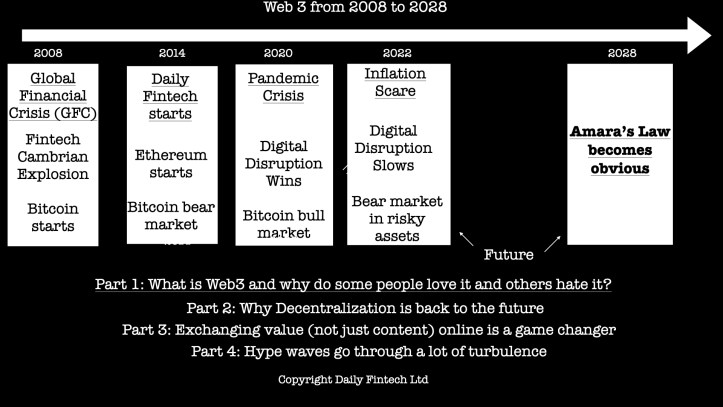Web3 Part 2 Why decentralisation is back to the future

The Internet was originally designed as a decentralized system to withstand attack by the Soviet Union during the cold war.
The Internet protocols are also permissionless. You just connect your system to the Internet. Nobody can stop you – except the market if you don’t add value.
That changed with Web 2 when centralized services dominated
So we should use the nerdily correct term redecentralization
Web3 redecentralization enables lots of big disruptive dreams such as:
– a search engine where you do not need to invest $ billions in a massive data center if you have a better algorithm than Google.
– a social network where users are paid a % of the ads that their chatter generates.
– sharing economy networks where the intermediary fee is 10x less than current services.
That is why we wrote as far back as 2016 that redecentralization will be as disruptive to big tech as banks.
Bitcoin and Blockchain is a key part of Redecentralization, but only one part.
Our research on earlier tech wave such as Mainframe and PC shows that the Competitive Advantage Period is getting shorter, which argues that the Web 2 centralized services wave may be cresting shortly.
Our research also shows that with each wave, more goes to open source. In the ReDecentralization wave, only the top of the stack is commercial but with no server costs and the economic model governed by a Distributed Autonomous Corporation that cannot raise prices, it is unlikely this will follow the VC funding trajectory. This new model will threaten the Big Tech incumbents. It should benefit the overall economy by reducing intermediation costs.
Some subjects are too complex for our short attention spans, so we do 4 posts one week apart, each one short enough not to lose your attention but in aggregate doing justice to the complexity of the subject. Stay tuned by subscribing.
Daily Fintech’s original insight is made available to you for US$143 a year (which equates to $2.75 per week). $2.75 buys you a coffee (maybe), or the cost of a week’s subscription to the global Fintech blog – caffeine for the mind that could be worth $ millions.
Bitcoin, Blockchain, Cryptocurrencies cryptoscams DeFi disruption redecentralization valueexchange
